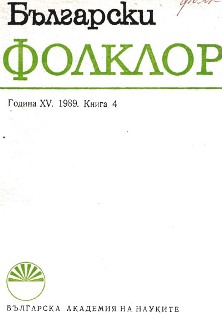Отново за светците в бълrарския фолклор
Once Again about Saints in Bulgarian Folklore
Author(s): Petar StefanovSubject(s): Anthropology
Published by: Институт за етнология и фолклористика с Етнографски музей при БАН
Summary/Abstract: The article offers an opinion on, rather than a solution to recurring issues related to the difficult task of reconstructing Bulgarian folk mythology. The analysis is centered around those personages and subject-matters about saints, which reveal clearly enough certain basic ideas within the system of Bulgarian worldview. The methods of research are oriented towards establishing the systemic relationships within an isochronic group of texts, regardless of their origin. In the study emphasis is put on the poetic image of the “holy woods” (“sveta gora”), which played a significant part in the minds of the Bulgarians from the Middle Ages. Its semantic features characterize it as a sacral center, an image of the world, a model of the universe. Being the result of a mythological way of thinking, this image gave rise later on to the toponym of the “holy woods of Mount Athos” (“Sveta gora Atonska”). The motifs “A Saint Sets Holy Woods on Fire” and “A Saint Is Building a Monastery or a Church in the Holy Woods” fit precisely into the scheme reconstructed by Ivan Dobrev of the Proto-Slavic Christmas myth of the disappearing and returning young god (see Ivan Dobrev’s study “Proizhod i znachenie na praslavyanskoto konsonantno i diftongichno sklonenie”, Sofia, 1982). The ideas about the end of the world and its rebirth form the basis of this scheme. The specific features of the plots centered around the second motif point to ideas associated with the original Creation. The first motif is in direct contrast with the second one in terms of ideas and meaning, and is related to the theme of the world’s destruction and subsequent re-creation. Other texts having a direct semantic relation to the ones mentioned above are also considered here. In these, some saints function as characters, whose temporary absence brings a breach of the natural and social order. The single variants retain the common semantic structure, which is strongly reminiscent of the calendar myths about the temporary disappearance of the deity, quite widespread throughout Mediterranean lands. The pair of motifs, “A Hero Sets the Boundary Line of a Wheat Field on Fire” and “A Saint Goes About the Boundary Line of a Green Field”, presents special interest within the context of ideas about the destruction and subsequent re-creation of the world.
Journal: Български фолклор
- Issue Year: XV/1989
- Issue No: 4
- Page Range: 21-29
- Page Count: 9
- Language: Bulgarian
- Content File-PDF

